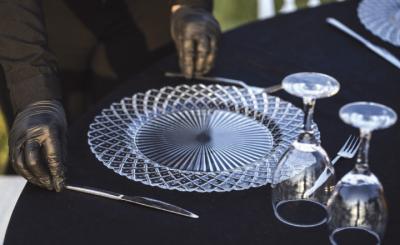Vendors have your back

How caterers, photographers and other event producers are modifying the ways they work to put safety first
Weddings in 2020 look very
different from how they used to. Today, masks are the must-have
accessory, backyards are the hottest reception venue, and cocktails are
served from trays (so long, open bar). To accommodate the ever-changing
world, where pandemic-related safety is the top priority, vendors have
had to develop innovative ways to make weddings happen without anyone
feeling like they’ve been cheated out of a memorable celebration. Below,
a glimpse at what’s happening today.
 Downsizing the guest list
Downsizing the guest list
Starting in March 2020, large social gatherings, including weddings, were prohibited in most states. Once they got over the initial shock, many engaged couples decided to postpone their weddings until 2021 or later. “I’d much rather wait to when the focus can be on our wedding versus the safety precautions we would have to take,” says Rebecca Waldman of New Orleans, who got engaged in September. Others have opted to marry on the date they’d initially planned but in a simpler style. Events named “microweddings” have all the features of a traditional wedding but on a smaller scale and with just a handful of loved ones. “Microweddings have a totally different vibe than traditional weddings,” says Joy Yagid, an event and family photographer at Joy Yagid Photography in Maplewood, N.J. “They feel more intimate and personal since only your core group of family and friends attends.”
Fabulous food for one
What’s
on the cocktail hour menu? Foods that can be individually served with
tongs by waiters, packaged in bento boxes, or served to guests seated at
tables. “We’re doing appetizers on tiny, individual plates, small
cheese boards and heirloom vegetable platters for two,” says Maire
Byrne, owner/chef of Thyme Café and Market, in Santa Monica, Calif.
Caterers are serving plated dinner entrees, too. “The few buffets that
we have done are with attendants serving.” This prevents guests from
handling the food and using communal utensils. With so many weddings
taking place outdoors, caterers are even serving boxed picnic fare.
Another fun, safe choice: a tasting menu that pairs food and wine in
single servings.
Keeping tabs on drinks
Though
some caterers will set up an open bar, especially at small, backyard
weddings with enough room for guests to socially distance, others, like
the Thyme Cafe, offer individual batch cocktails. “We serve them in
mason jars that someone can just grab,” says Byrne. “We have also done a
lot of butler service, where we take an order and then deliver the
drink to the guest.”
The cake isn’t crumbling
While they’re not commissioning towering tiers for 200 guests,
couples still want a wedding cake with handmade sugar roses, royal icing
and delicious layers – a scaled-down version of their original design.
Besides wedding cake, some guests are offered other sweet treats like
single-serve pies and cookies from dessert carts staffed by waiters.
Couples are also arranging for cupcakes to be delivered to loved ones
while watching their wedding live using Zoom.
Finding out about flowers
Floral
pros are also turning to Zoom meetings to talk to clients, present
their ideas and even pick out vessels together, says Karen Roa, owner
and artistic director of Alee Floral Design, in Yorktown, Va. One thing
that brides getting married during a pandemic have come to understand:
Overseas shipping is still unpredictable, which means that at the last
minute, florists and floral designers may have to substitute a different
flower than what they wanted.
Entertainment is optimal
DJs
aren’t just available to get your guests up on their feet – now their
services may include live-streaming the party for family and friends who
couldn’t be there in person. “Hiring a DJ may be safer in that it is
one person versus multiple musicians, so fewer chances of transmission,”
says Amy Nichols of Amy Nichols Special Events in San Francisco. But
before hiring anyone, check with your state’s rules. “In California,
weddings are currently limited to two hours only – no reception – just a
ceremony,” she says. “So, the only music would be for the ceremony,
where it would make sense to only hire a solo musician.”
Say cheese from a distance
Even though weddings are downsizing, couples still want them documented. But instead of hiring a photographer for eight to 10 hours, which is typical for a 200-person wedding, couples are looking to hire photographers for shorter shoots. Yagid now offers microweddingfriendly packages that cover 90 minutes to two hours of shooting. To keep safely away from others, photographers are using longer lenses, which allow them to distance themselves but still capture the wedding scene.
